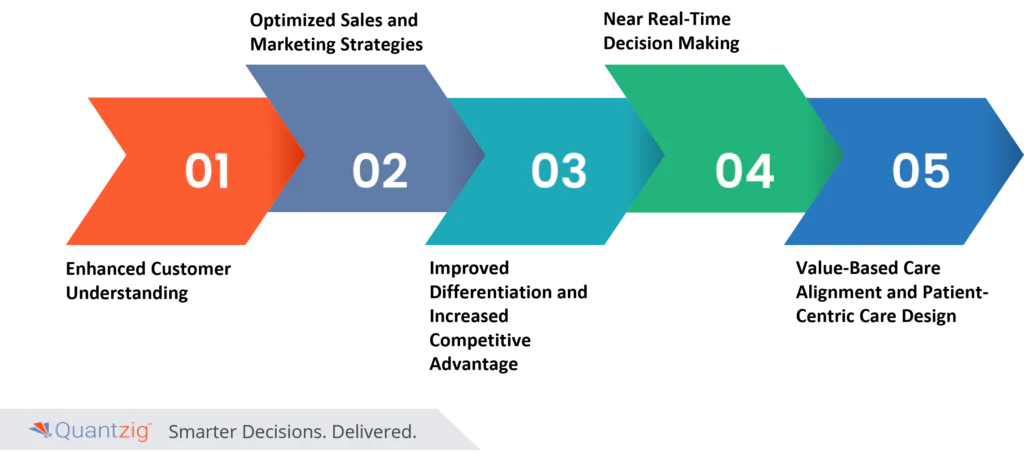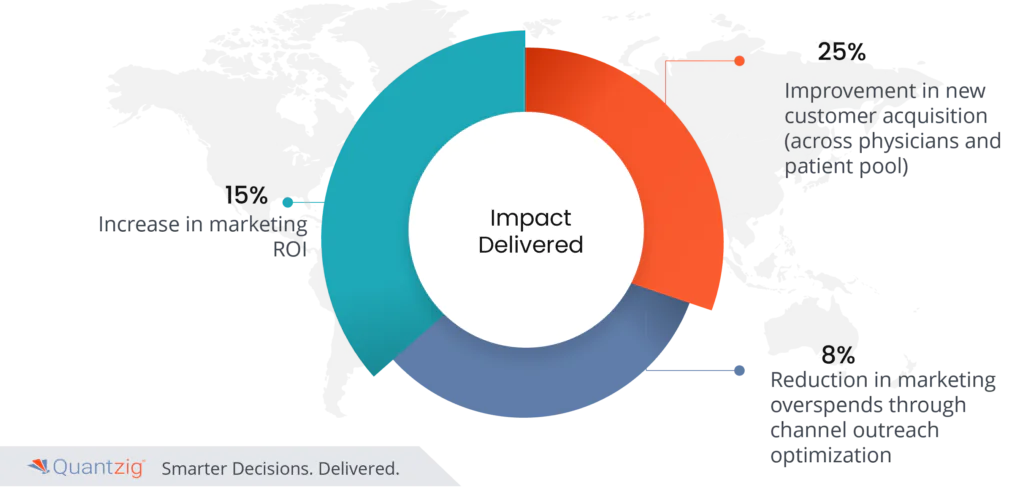Written By: Rishab Dandriyal
In today’s data-driven healthcare landscape, navigating the complex world of pharma customer leadership demands more than just persuasive charm and industry expertise. Enter pharma commercial analytics, a potent weapon in the modern pharma arsenal, transforming customer engagement from an art form to a science. By harnessing the power of data, Life Sciences Companies can unlock a treasure trove of insights, forge collaborative partnerships with healthcare professionals and stakeholders, optimize market strategies, and ultimately ensure their products reach the patients who need them most. All of which helps stay on top of customer expectations and needs to ensure accurate brand positioning to ensure strong revenue growth. This article delves into the essential ingredients of commercial analytics for pharma data-powered customer leadership, empowering you to leverage data’s transformative potential and solidify your place as a leader in this ever-evolving field.
Table of Contents
Challenges/Problems faced while implementing Commercial Analytics for Pharma Customer Leadership
1. The challenge to cater to the different needs of different customers:
Due to the immense number and variety of customers in the value chain, each with its own specific needs, the task of fulfilling each of those needs becomes a largely complex endeavor.
- Physicians are looking for the effectiveness and efficacy of the drug as this directly affects their preferences for prescription to provide the best medication possible to their patients.
- On the other hand, patients are worried about the easy accessibility of the drugs to enable convenient consumption. Alongside that, patients also take into consideration the insurance coverage of the medications while paying special attention to the safety metrics of the same.
- Payers are concerned about the accurate differentiation of drugs in the same therapy area to provide maximum coverage to its customers as the coverage helps gain customer trust and credibility for their prescriptions and methodologies.
2. The challenge of handling diverse data, building optimal strategies, and taking needed actions
Pharma’s data wealth can be both a blessing and a curse. Diverse data types from clinical trials to real-world usage offer a deep understanding of drugs, but their varied formats and inherent complexities create hurdles. Mastering this data requires tackling three key challenges.
- Effective Data Management: Combining clean clinical trial data with messy real-world observations like patient surveys needs smart tools and expertise. Unstandardized formats, accounting for biases, and not bridging the gap between controlled settings and everyday practice lead to drowning in inconsistencies.
- Sound Strategy Development: Sifting through data mountains to identify the right metrics amidst a flood of information can be overwhelming. Focusing on irrelevant outcomes or misinterpreting trends leads to misguided strategies.
- From Insights to Action: Even the most insightful analyses are useless without actionable steps. Translating data into concrete decisions often collides with regulatory walls and communication breakdowns which leads to failure in the development of tangible actions.
Request a free proposal to understand how.
Benefits of Implementing Commercial Analytics for Pharma Customer Leadership

1. Enhanced Customer Understanding:
Analyzing the data from various sources to uncover customer preferences, frustrations, and decision-making drivers. Additionally, it allows precision targeting, facilitating segment customers based on insights and tailoring marketing, engagement, and support to resonate with each segment. It also helps anticipate customers’ future needs and behavior to proactively offer relevant solutions and information.
2. Optimized Sales and Marketing Strategies:
It allows for data-driven decisions that optimize resource allocation, campaign design, and sales tactics based on real-time insights. Subsequently, it helps boost performance by utilizing sales data to identify strengths and weaknesses, improve training, and predict outcomes. This allows one to allocate marketing resources to channels and messages that resonate most with specific customer segments.
3. Improved Differentiation and Increased Competitive Advantage:
Gaps in the market can be identified by using data to pinpoint unmet customer needs and develop differentiated offerings and services. This is further aided by monitoring market trends and competitor activity in real time to adapt strategies and maintain one’s edge. Apart from such direct benefits, data also helps build trust and credibility by presenting data-driven insights to support one’s value proposition.
4. Near Real-Time Decision Making:
Analyzing data from interactions, surveys, and market activity to make agile decisions and adjust strategies which result in instantaneous decision-making. This fast-paced decision-making helps one seize sudden new opportunities by identifying and capitalizing on emerging trends and customer preferences before the competitors. After such opportunities are identified and are analyzed for risk which can be easily conducted by analyzing data to predict potential challenges and proactively mitigating risks.
5. Value-Based Care Alignment:
Commercial analysis also helps quantify the clinical and economic impact of your products and services through data analysis. This then leads to various steps like collaborating with healthcare providers based on shared data insights to improve patient outcomes. This is where one uses data to identify cost-effective interventions and optimize healthcare delivery.
6. Patient-Centric Care Design:
Most importantly, it allows the firms to understand the patients better by analyzing data from various sources to understand patient needs, preferences, and treatment trajectories. A greater understanding is put into utilization by developing targeted interventions and support programs based on individual patient data. Moreover, tracking and measuring the impact of interventions can be used to continuously improve patient care and experiences.
Success Story:
Revolutionizing Pharma Customer Leadership: How Quantzig’s Commercial Analytics Essentials Transformed a Client’s Success
Client location:
USA
Challenges faced by the client:
The client was spending a lot of budget marketing across channels for its newly launched drug. The ROI was not up to mark and hence the client was looking for ways to identify where they were going wrong and how they could improve the overall marketing approach by focusing more on what the customers (physicians and patients) are looking for.
Solutions offered by QZ:

Quantzig played a pivotal role in our strategic endeavors by conducting a comprehensive evaluation of the repercussions of diverse marketing activities targeting both physicians and patients across multiple channels. The emphasis was not only on assessing the overall impact but also on delving into the nuanced distinctions in the effectiveness of various messages disseminated through the same channel. This meticulous analysis aimed at identifying the optimal message and channel combinations that would yield the most impactful outcomes when reaching out to our target customers.
To achieve this, we employed a sophisticated blend of attribution analysis and creative content analysis, with a particular focus on dissecting customer segments. The attribution analysis allowed us to discern the contribution of each marketing touchpoint to the overall customer journey and improve customer-centricity, providing valuable insights into the touchpoints that played a decisive role in influencing the target audience. Simultaneously, the creative content analysis delved into the qualitative aspects of the messages, gauging their resonance with different customer segments.
These multifaceted intelligent technology approaches enabled us to not only understand the broader trends in customer engagement but also to tailor our strategies based on the preferences and receptiveness of distinct customer segments. By deciphering the differential impact of messages and channels across various customer segments, we were able to fine-tune our marketing outreach strategy. The goal was to design a strategy that not only maximized reach but also resonated deeply with our audience, fostering a more personalized and compelling connection.
The collaborative efforts with us culminated in the development of an optimal marketing outreach strategy that is not just data-driven but also highly tailored to the unique preferences and behaviors of our diverse customer base. This strategic refinement has not only enhanced the efficiency of our marketing endeavors but has also positioned us to establish more meaningful and enduring connections with both physicians and patients alike.
Impact Delivered

- 15% increase in marketing ROI
- 25% improvement in new customer acquisition (across physicians and patient pool)
- 8% reduction in marketing overspends through channel outreach optimization.
By embracing CAE, Pharma customer leadership moves beyond intuition and guesswork to truly understand customers, optimize decisions, and deliver value across the healthcare ecosystem. This data-driven approach paves the way for a future where Pharma thrives by aligning with value-based care and designing patient-centric solutions, ultimately leading to improved health outcomes for all.
“Empower your business with the Commercial Analytics—ensuring accuracy, compliance, and strategic excellence. Elevate your operations to new heights by investing in the backbone of successful decision-making and sustained growth.”


